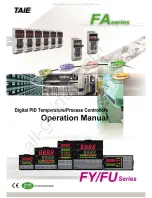
32
CNT-SVX07D-EN
Sequence of operations
Occupied mode
In occupied mode, the controller maintains the zone temperature based on the occupied heating
or cooling setpoints. The controller uses the occupied mode as a default mode when other forms
of occupancy request are not present. The fan will run continuously. The outdoor air damper will
close when the fan is off. The temperature setpoints can be local (hard-wired), communicated, or
stored default values (configurable using the Rover service tool).
Unoccupied mode
In unoccupied mode, the controller attempts to maintain the zone temperature based on the
unoccupied heating or cooling setpoint. The fan will cycle between high speed and off. The outdoor
air damper will remain closed, unless economizing. The controller always uses the stored default
setpoint values (configurable using the Rover service tool), regardless of the presence of a hard-
wired or communicated setpoint value.
Occupied standby mode
The controller is placed in occupied standby mode only when a communicated occupied request
is combined with an unoccupied request from occupancy binary input BI3. In occupied standby
mode, the controller maintains the zone temperature based on the occupied standby heating or
cooling setpoints. Because the occupied standby setpoints are typically spread 2°F (1.1°C) in either
direction and the outdoor air damper is closed, this mode reduces the demand for heating and
cooling the space. The fan will run as configured (continuous or cycling) for occupied mode. The
controller always uses the stored default setpoint values (configurable using the Rover service
tool), regardless of hard-wired or communicated setpoint values. In addition, the outdoor air
damper uses the Economizer Occupied Standby Minimum Position setpoint to reduce the
ventilation rate.
Occupied bypass mode
The controller is placed in occupied bypass mode when the controller is operating in the
unoccupied mode and either the timed override
ON
button on the Trane zone sensor is pressed or
the controller receives a communicated occupied bypass signal from a BAS. In occupied bypass
mode, the controller maintains the zone temperature based on the occupied heating or cooling
setpoints. The fan will run as configured (continuous or cycling). The outdoor air damper will close
when the fan is off. The controller will remain in occupied bypass mode until either the
CANCEL
button is pressed on the Trane zone sensor or the occupied bypass time (configurable using the
Rover service tool) expires. The temperature setpoints can be local (hard-wired), communicated,
or stored default values (also configurable using the Rover service tool).
Timed override control
If the zone sensor has a timed override option (
ON
/
CANCEL
buttons), pushing the
ON
button initiates
a timed override on request. A timed override on request changes the occupancy mode from
unoccupied mode to occupied bypass mode. In occupied bypass mode, the controller controls the
zone temperature based on the occupied heating or cooling setpoints. The occupied bypass time,
which resides in the Tracer ZN521 and defines the duration of the override, is configurable from 0
to 240 minutes (default value of 120 minutes). When the occupied bypass time expires, the unit
transitions from occupied bypass mode to unoccupied mode. Pushing the
CANCEL
button cancels
the timed override request. A timed override cancel request will end the timed override before the
occupied bypass time has expired and will transition the unit from occupied bypass mode to
unoccupied mode.
If the controller is in any mode other than unoccupied when the
ON
button is pressed, the controller
still starts the occupied bypass timer without changing the mode to occupied bypass. If the
controller is placed in unoccupied mode before the occupied bypass timer expires, the controller
Содержание Tracer ZN521
Страница 59: ......
















































